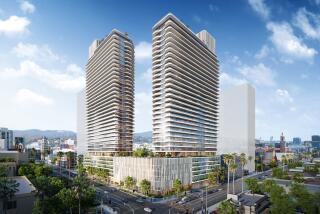A Fight to Unlock a ‘Gateway to L.A.’
- Share via
For years motorists have been speeding past a sliver of land bordering the Harbor Freeway in downtown Los Angeles. Hardly anyone gives the sloping, ivy-covered strip a glance.
Now, the narrow three-block-long parcel suddenly has become the center of a controversy over a proposed high-rise development--and dramatic “Gateway to Los Angeles” freeway bridge--that enthusiasts say could mean added billions with which to fund California’s freeways.
The project would mix private investment and public lands under the state’s “airspace” leasing program by which commercial development is permitted on spare land along freeway rights of way. Several such leases negotiated with Caltrans in effect now, including space under the downtown Santa Monica Freeway viaduct used by an automobile agency for storage and land next to the Hollywood Freeway on-ramp at Vermont Avenue where a large hotel is under construction.
The strip of land sloping at a 45-degree angle next to the west side of the Harbor Freeway between 4th and 6th streets, vacant since the freeway was cut through downtown in the 1950s, may seem an unlikely building site. Not so, though, to Air Rights Development Corp. of Brentwood, a partnership headed by developer Robert MacLeod.
The corporation came up with what Caltrans called a “unique idea” for developing the property. MacLeod envisions a $124-million project, consisting of an office building, a matching 250-room hotel building and a landscaped plaza atop a parking garage between the buildings, each rising 15 stories above the edge of the busy freeway.
Also part of MacLeod’s plan is a pedestrian-park bridge extending over the Harbor Freeway linking the area on the west side of the freeway to downtown’s heavily developed high-rise financial and hotel center along Figueroa Street. MacLeod says he is uncertain how the bridge part of the plan, intended to enhance the project’s “Gateway to Los Angeles” character, would be financed. Drawing on freeway funds is considered a possibility.
Little was known publicly about the plan until recently when enthusiastic Caltrans officials asked the California Transportation Commission to approve the property’s development by Air Rights, the only interested party.
The commission liked the idea of putting unused freeway space to work. As the commission chairman, Orange County Supervisor Bruce Nestande, put it, the proposal is “attractive and (has) a lot of positives. . . .” But the proposal drew formidable opposition, notably from the Unocal Corp., whose headquarters building would be a next-door neighbor, from other commercial interests nearby and from some city officials.
In the face of the strong opposition, the commission on Dec. 12 turned down Caltrans’ recommended airspace lease, approving instead a year’s extension of a 1984 letter of understanding which gives Air Rights Development Corp. the right to refine its plans, and during which the state agreed not to negotiate with another developer. Nestande said that unless the corporation can win over its would-be neighbors, “it’s a dead project.”
Caltrans officials say the Harbor Freeway parcel, although relatively small--three blocks long and about a third of a short block wide--could bring in a guaranteed bottom rental of $860,000 a year from the hotel and office building. But the lease, Caltrans says, also could return as much as $615 million over its 75-year lifetime based on a percentage--also payable under the proposed contract--of the project’s anticipated gross income. This would average about $8.2 million a year.
However, revenue that the project would contribute to California’s freeway system could be vastly more, according to Caltrans officials, because the federal government provides up to $10 for each highway dollar that the state generates. Thus, by the most optimistic calculations, the return could amount to more than $6 billion over a 75-year period.
While Air Rights’ hotel-office building would “lead the way,” as MacLeod puts it, for more development west of the Harbor Freeway, the project faces an uphill fight.
Officials of Unocal, a pioneer developer on the west side of the Harbor Freeway with its headquarters building, argued with fellow opponents at City Hall that the narrow strip should remain as open space because of downtown’s lack of parkland and green space. Others worry about traffic and other problems that the large commercial complex--one of many expected to shoot up on that side of the freeway--would create.
A spokesman for Unocal, which was represented at the Transportation Commission hearing by former Los Angeles County Dist. Atty. Robert Philibosian, denied, as contended by Caltrans officials, that Unocal opposed the proposed twin towers because the structures would block the view from the Unocal headquarters building.
The project has also run into opposition from Center City West, a group of 22 large property owners who control more than 125 acres from 9th Street to Temple Street west of the Harbor Freeway.
The group’s executive director, Graham Kaye-Eddie, an architect-planner, says the landowners are aligned solidly against the project. He says the proposed development would create problems for open space and traffic circulation and that the parcel should be used for freeway on- and off-ramps, not a commercial venture.
Both City Councilmen Gilbert Lindsay and John Ferraro said Caltrans should study the parcel for possible answers to transportation needs, such as freeway access, before any airspace building project is undertaken.
The developers came up with what Caltrans called a “unique idea” for the property. Envisioned is a $124-million project, consisting of an office building, a matching 250-room hotel building and a landscaped plaza atop a parking garage between the buildings, each rising 15 stories above the edge of the busy Harbor Freeway.
More to Read
Sign up for Essential California
The most important California stories and recommendations in your inbox every morning.
You may occasionally receive promotional content from the Los Angeles Times.













